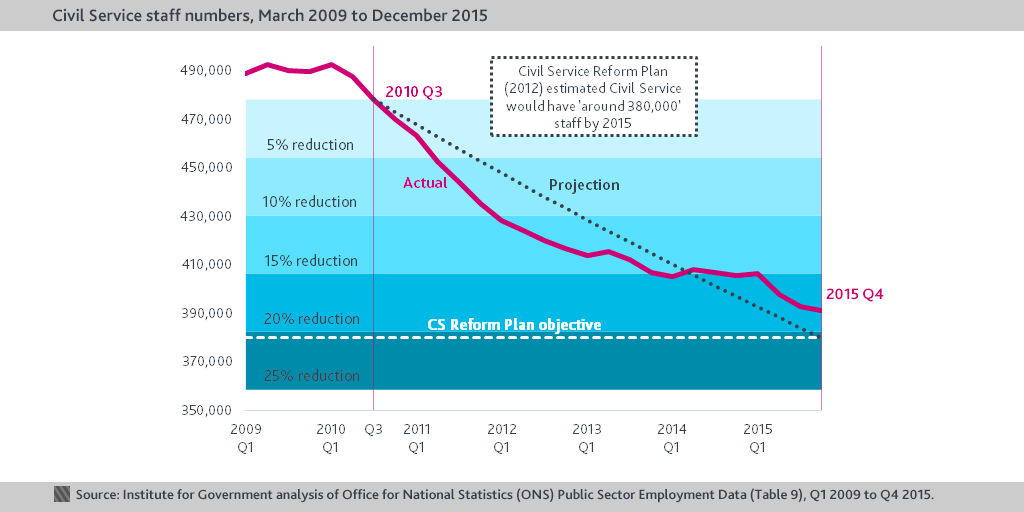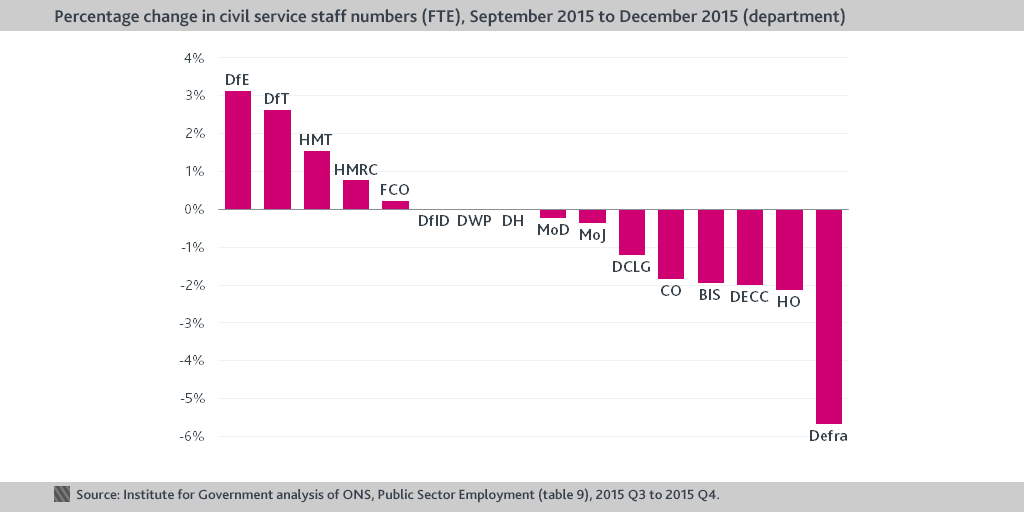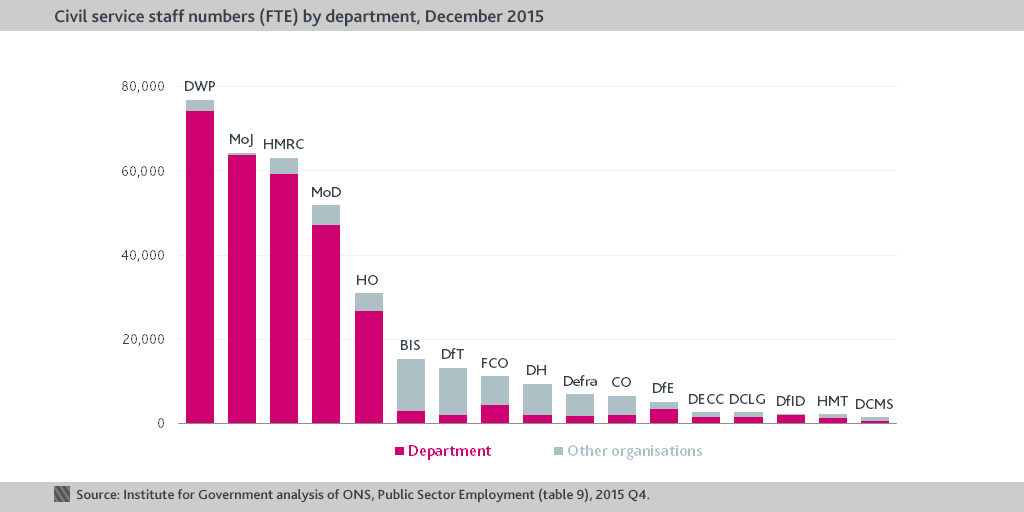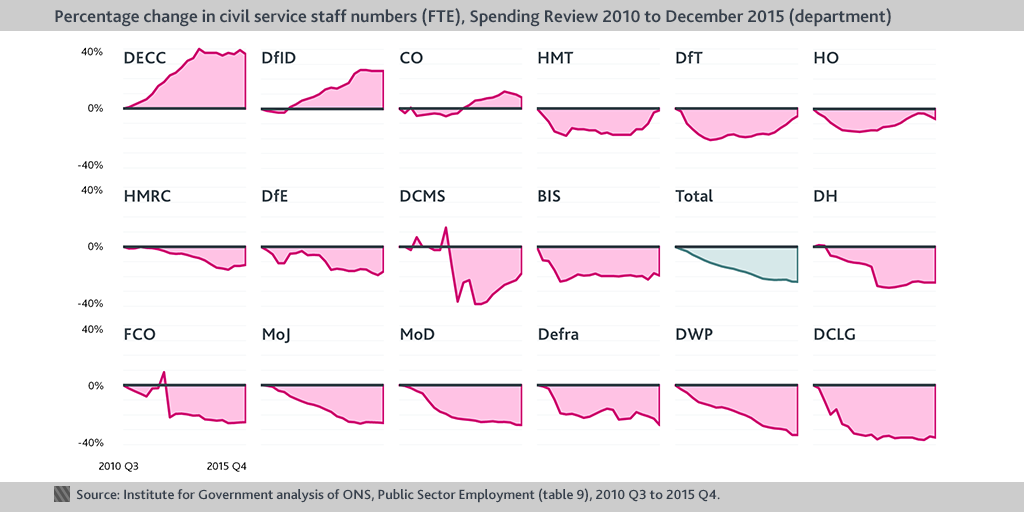The latest Office for National Statistics (ONS) figures show an 18% reduction in the number of civil servants since 2010 – falling short of the aspiration set out in the 2012 Civil Service Reform Plan by over 10,000 full-time equivalent (FTE). With further challenges coming out of the Budget, what comes next? Emily Andrews looks at the numbers.
In this week’s Budget, the Chancellor set the government some new challenges: around 70 new measures to implement (including complex reform of the education system), and a further £3.5 billion in ‘efficiency’ savings to find. This work will be done by a Civil Service that has shrunk by 18% since 2010, and will continue to get smaller if those savings are to be found. Serious workforce planning will be needed to make all of this happen, but the lack of detail in the Single Departmental Plans has left us asking: where will those reductions come from?
At the end of 2015 there were 391,360 civil servants: 11,360 more than the aspiration set out in the Civil Service Reform Plan.
At the end of 2015, there were 391,360 civil servants (FTE). This is down 0.4% from the previous quarter, and 18% from 2010.
This brings us to the end of a story which began in 2012, when the Civil Service Reform Plan ‘estimated that by 2015 the Civil Service will be around 23% smaller than it was in March 2010, operating with around 380,000 staff’. Despite steep reductions in the first half of the Parliament, and continued reductions in 2015, the levelling off which began in 2013 has left the Civil Service 11,360 FTE away from that estimated figure.
After last month’s Spending Review, the Cabinet Secretary, Sir Jeremy Heywood, declared, ‘[T]here is no predetermined target for reducing numbers. There is no ‘right size’ for the Civil Service’.
Seven departments have lost staff, but reclassification in Scotland is largely responsible for bringing numbers down at the end of 2015
Defra – the smallest department in Whitehall – lost nearly 6% of its staff (110 FTE) in the last quarter. The Home Office lost 580 FTE, shrinking by 2.8%.
This week's heavily trailed Budget announcement that every school in England will be an academy by the end of 2020 will ramp up the workload in DfE, which grew by 3% in the last quarter. DfT and HMT have both continued their recent trend of growth, and are now respectively only 5% and 1% smaller than in 2010.
A closer look at the numbers shows that the overall reductions in the last quarter were largely due to the reclassification of some civil servants in the Scottish Government. In October, Historic Scotland merged with another Scottish Government Executive non-departmental public body (NDPB). With this, 1,100 FTE staff ceased to be classified as civil servants – although many of them may still be doing the same job.
These changes have not changed the overall distribution of staff across departments. The largest five departmental groups – DWP, MoJ, HMRC, MoD and HO – still make up three-quarters of the whole Civil Service workforce.
Most government departments face staff reductions over the next five years, but we don’t know how large.
Sir Jeremy Heywood may be correct that there is no ‘right size’ for the whole Civil Service, but workforce planning at a departmental level is critical. Ministers and senior leaders in government need to make sure they have enough staff with the right skills and experience to implement their policies and keep public services running.
We previously thought the Single Departmental Plans (SDP) – published last month – might support this departmental planning. Last summer, John Manzoni, Chief Executive of the Civil Service, wrote that ’each department is taking responsibility, through its Single Departmental Plan, for assessing its own priorities and the workforce needed to deliver them’. Unfortunately, the published SDPs do not contain a clear list of ministerial priorities, and give no indication of the workforce planning going on in departments to meet them.
We can find hints that this workforce planning is happening in other departmental documents and announcements. MoD – which has shrunk by 27% since 2010 – will reduce its civilian staff by a further 30% in this Parliament. HMRC’s staff numbers are expected to fall to 52,000 by April next year, a 23% reduction from 2010. However, the business transformation needed to run its operation on reduced numbers will involve bringing in new – specifically digital – skills. It is currently only 12% smaller than in 2010, and grew by 450 FTE at the end of last year.
If the Chancellor is to achieve the extra £3.5 billion of savings by 2019/20 announced in this week's Budget, then further Civil Service staff reductions are inevitable. The question is: will departments get enough direction to tailor their reductions to their work?
- Topic
- Civil service



